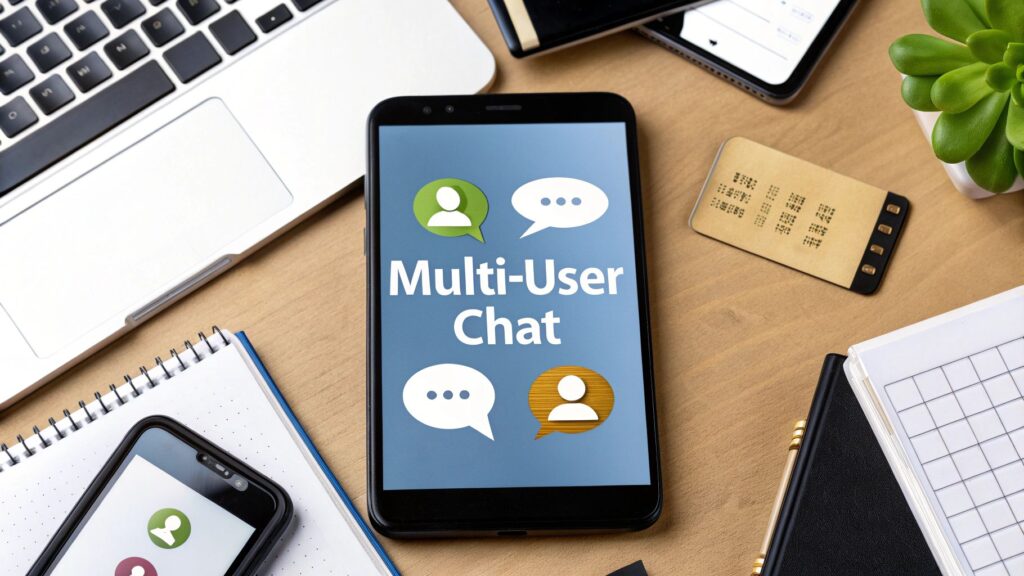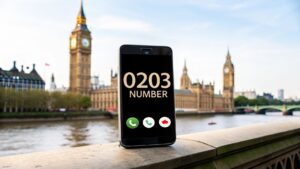Yes, you can set up WhatsApp Business with multiple users by linking up to four extra devices to your main business phone. But for serious teamwork—more users, better management, and professional tools—the WhatsApp Business API is the solution you need. Let's walk through how to choose the right path for your business.
Why a Single WhatsApp Account Is Holding Your Team Back
It's a familiar story for many growing businesses. One company phone gets passed around the office, with a single person trying to manage every customer chat on WhatsApp. Initially, it seems manageable. But as your business grows, this simple setup quickly becomes a bottleneck, leading to missed opportunities and customer frustration.
Think about it. A new lead sends a message with an urgent question. The person with the phone is busy with another customer, so the message sits unanswered for hours. By the time someone sees it, that potential customer has likely moved on to a competitor. This isn't just a hypothetical problem; it's a daily reality for businesses trying to scale with a one-person system.
This setup doesn't just frustrate customers—it creates friction for your team. Passing a phone back and forth is inefficient. With no real oversight, it’s impossible to track who said what to whom. This disorganisation often leads to embarrassing mix-ups, like two different team members giving contradictory advice to the same person.
The Growing Need for Team Access
Switching to a WhatsApp Business multiple users setup isn't just a convenience; it's a strategic necessity. It's about building a communication system that can support your growth, not hinder it.
With over 50 million businesses on the app and messages boasting an incredible 98% open rate, you can't afford to get this wrong. WhatsApp is an engagement powerhouse. Relying on a single user is like trying to run a bustling restaurant with only one waiter. You can get a clearer picture of its incredible reach by checking this breakdown of WhatsApp's latest statistics.
To move beyond the single-user trap, you have two main options:
- Linked Devices: A simple, built-in feature of the standard WhatsApp Business app. It’s a good starting point for very small teams just beginning to expand.
- The WhatsApp Business API: The more robust solution. It integrates with third-party platforms to create a professional, shared team inbox packed with advanced features for serious collaboration.
To help you decide, let's compare what you get with a standard setup versus a true multi-user solution.
Single User vs Multi-User WhatsApp Business at a Glance
| Feature | Single User (Standard App) | Multiple Users (API Solution) |
|---|---|---|
| User Limit | 1 phone + 4 linked devices | Virtually unlimited users |
| Chat Assignment | Manual, no official system | Automated or manual assignment |
| Team Performance | No built-in analytics | Detailed performance reports |
| Automation | Basic quick replies only | Advanced chatbots & integrations |
| Central Dashboard | No central oversight | Shared team inbox, full visibility |
As you can see, while the standard app offers a basic entry point, an API-powered solution is what truly unlocks professional, collaborative customer support on WhatsApp.
The image below clearly shows the performance difference between a single-user setup and a multi-user approach.
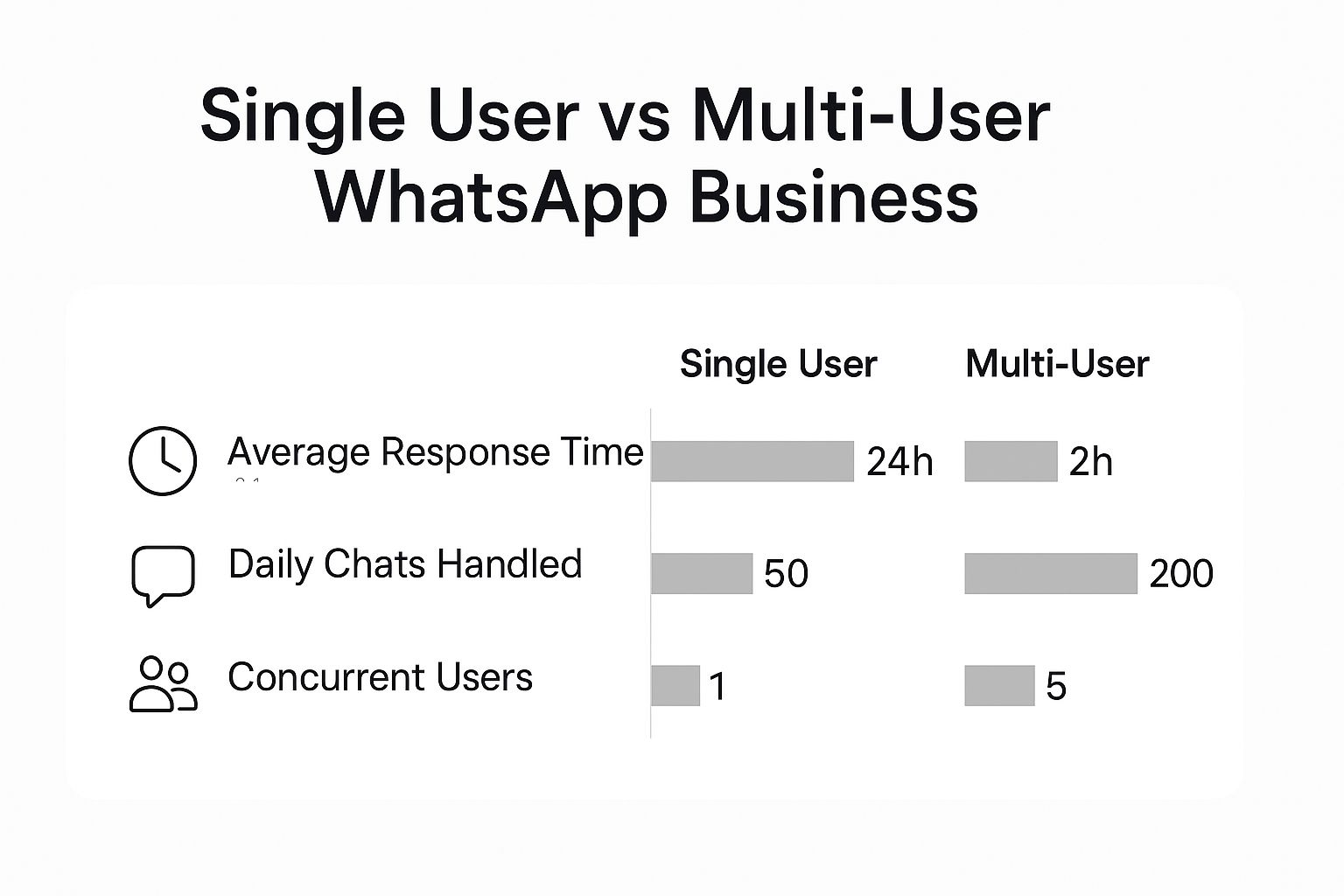
The data speaks for itself. Moving to a multi-user system significantly boosts your team's response times and the number of conversations they can handle at once.
Using Linked Devices for Small Team Collaboration

When your small team starts to feel the strain of sharing one phone, the first logical step is WhatsApp’s 'Linked Devices' feature. It's a built-in, no-cost way to give more people access, letting you connect up to four additional devices (like office PCs or tablets) to your main business account. It's the most basic way to start using WhatsApp Business for multiple users.
Getting set up is straightforward. Open WhatsApp Web or the Desktop app on a new device to generate a QR code. Then, on your main business phone, go to the 'Linked Devices' menu and scan that code. Instantly, your chats are mirrored on the second screen, and another team member can start responding.
This is genuinely useful for a small team of two or three managing customer messages from their desks or home. A great benefit is that the main phone no longer needs to be online for the linked devices to work, giving you more flexibility.
The Hidden Costs of Simplicity
But here’s the catch: that simplicity comes with limitations that can quickly lead to chaos as you get busier. The main issue is a total lack of accountability. Every linked device acts as the same user, so you have no way of knowing which team member sent which message.
Imagine this: a customer sends a tricky technical question. Two of your team members, both eager to help, start typing a reply simultaneously, completely unaware of each other. The customer receives two different answers moments apart. It’s confusing for them and makes your business look disorganised.
The biggest drawback of Linked Devices is its inability to assign chats or track individual performance. It’s like a team of receptionists sharing a single notepad—functional for a moment, but a recipe for confusion once things get busy.
Without proper tools, your team is flying blind. There’s no way to assign a conversation to the best person, no function to mark an issue as 'resolved', and no way to leave an internal note for a colleague.
Knowing When You've Outgrown Linked Devices
It doesn't take long to spot the signs that your business has moved beyond this basic setup. If your team is constantly asking these questions, it's time for a more robust solution:
- "Did anyone reply to this yet?" Without a system to track open chats, customer queries can easily fall through the cracks.
- "Who told the customer that?" Are customers receiving conflicting information from different team members?
- "How are we performing?" Do you have any insight into response times or how many chats each person is handling?
- "Is the workload balanced?" Is one person swamped with messages while others have spare capacity?
While Linked Devices is a great start, it’s a temporary fix. It lacks the professional tools—like chat assignments, permissions, and performance analytics—that are crucial for scaling your support. This is the point where you need to look at advanced solutions built on the WhatsApp Business API.
How the WhatsApp Business API Unlocks Real Teamwork
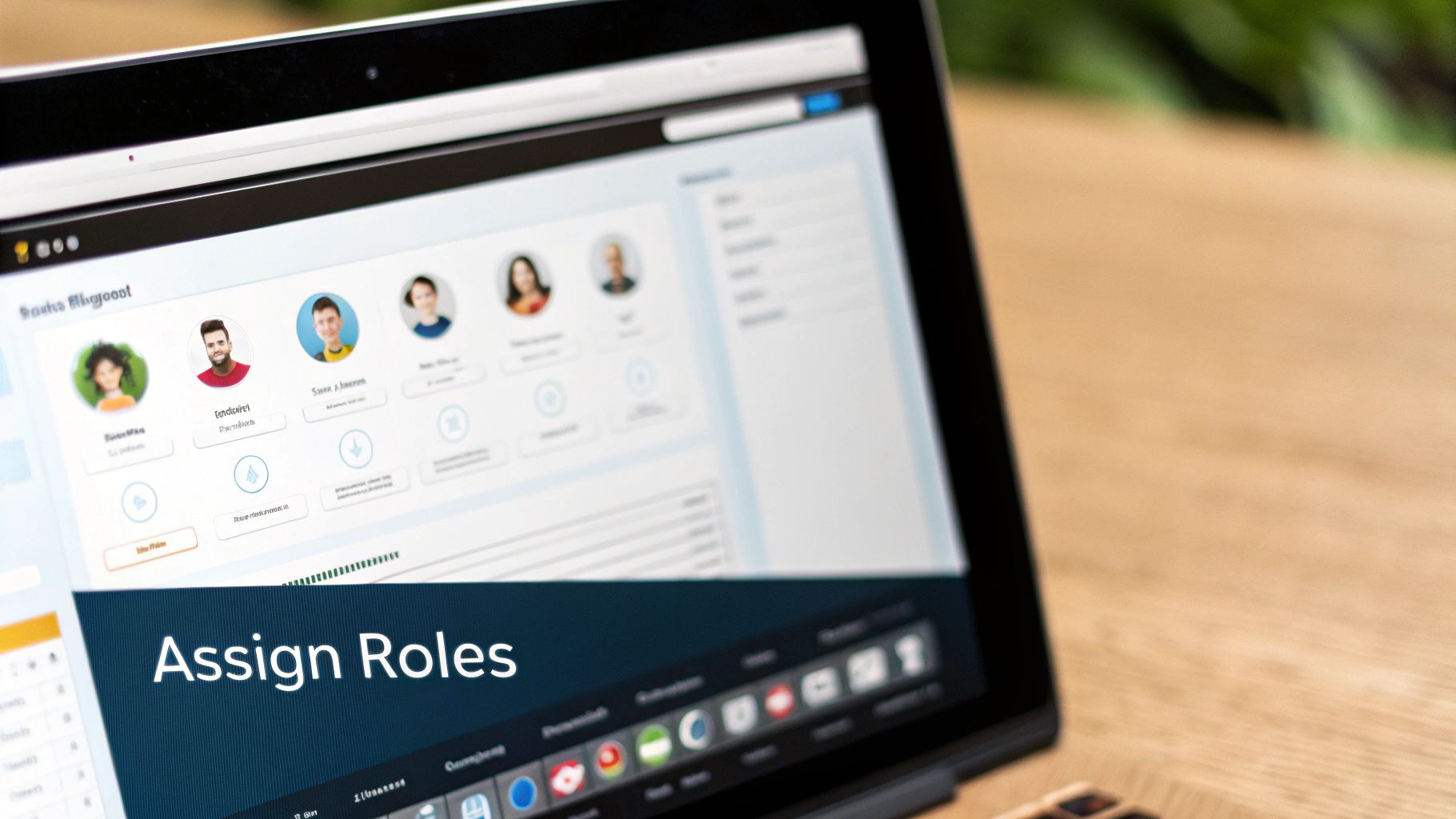
If the Linked Devices feature feels like a temporary fix, that's because it is. For a scalable, professional solution, you need the WhatsApp Business API. This is where you move beyond simple workarounds and into a system truly built for teamwork. The term "API" might sound technical, but you don't need to be a developer to benefit from it.
Think of the API as a special key. This key doesn't just open WhatsApp; it unlocks powerful third-party software platforms designed for managing WhatsApp Business with multiple users. These platforms serve as a central hub for all your customer conversations.
Suddenly, your multi-device setup transforms into a streamlined, shared team inbox. It’s a single dashboard where every message lives, and every team member can log in with their own account. This gives you complete visibility over who is talking to whom, ensuring nothing gets lost.
More Than Just a Shared Inbox
A shared inbox is a great start, but the real power of an API solution comes from the professional tools it provides. These features are designed to solve the exact problems that arise when multiple people handle customer communications.
For instance, imagine a customer has a complex technical issue. Instead of shouting across the office, you can assign the entire conversation directly to your technical expert. They get a notification and can instantly see the full chat history, ready to help.
What’s more, you can leave private, internal notes within a chat that only your team can see. A sales agent can close a deal and add a note for the support team: "New client, follow up in one week about their setup." This creates a seamless handover, so the customer never feels like they're being passed around.
The WhatsApp Business API transforms a simple messaging app into a fully-fledged customer support and sales powerhouse. It’s not just about adding more users; it’s about giving them the tools they need to work together effectively.
Tracking Performance and Setting Permissions
One of the biggest frustrations with the standard app is the lack of analytics. With an API solution, you gain access to a wealth of data, allowing you to answer crucial business questions:
- Who are our top-performing agents? Track how many chats each team member handles and resolves.
- What is our average response time? See exactly how quickly your team is getting back to customers.
- What are our busiest times? Understand when you need more staff online to handle customer demand.
This data is vital for improving your service. On top of that, you can set different permission levels for each user. A junior team member might only respond to messages, while a manager can access analytics and assign chats. This control is essential for maintaining organisation as your team grows.
The rising importance of WhatsApp for UK businesses makes these capabilities critical. Recent figures show that over 54% of consumers prefer using platforms like WhatsApp for customer service. The adoption of integrated chatbots has also surged by 92% since 2019, showing a huge demand for responsive communication. To dive deeper, you can discover more insights about WhatsApp Business growth on Trengo.com. This shift in consumer behaviour makes a scalable solution a necessity for staying competitive.
Choosing the Right Multi-User WhatsApp Solution
So, you have two main paths for getting your whole team on WhatsApp Business: the straightforward Linked Devices feature and the more powerful WhatsApp Business API. The big question is, which one is right for your business? This isn't just a tech decision; it's about matching the tool to your team's size, budget, and customer expectations.
Making the right call boils down to an honest look at where your business is today and where you want it to be tomorrow. A few direct questions can point you in the right direction. How many people need access right now? Is it just you and a partner, or a team of five or more? The answer to that alone can make the choice much clearer.
Evaluate Your Team and Workflow
First, take a look at your team's setup. For a solo entrepreneur or a small team of two or three, the free Linked Devices feature is often enough to get started. It provides basic access across a few devices without costing a penny, which is a massive win when you're watching expenses.
However, the moment you need to assign conversations or know who said what, its limitations become clear. If your process involves handing off customers from sales to support, or if you need to route specific enquiries to the right expert, you've already outgrown the basic app.
Think about it this way: a customer asks for a quote on a custom job. With Linked Devices, anyone logged in can reply. With an API solution, you can instantly assign that chat to your product specialist. That ensures an expert handles the query from the start, which is a much better experience for everyone.
Must-Have Features vs Nice-to-Have Extras
Now, make a simple list of your absolute must-haves. Be honest about what you genuinely need to operate effectively.
- Chat Assignment: Is it critical to route specific chats to individual team members?
- Performance Analytics: Do you need to track how quickly your team responds or see how many chats each person handles?
- CRM Integration: Is linking WhatsApp with your existing customer database a deal-breaker?
- Automation & Chatbots: Do you want to use automated welcome messages or chatbots to answer common questions 24/7?
If you answered "yes" to even one of these, an API-based solution is your only viable path. These professional features simply don't exist in the standard WhatsApp Business app.
Choosing the right solution is a balancing act between your immediate budget and your long-term need for professional tools. A free solution might save you money today, but a robust API platform could prevent lost sales and customer frustration tomorrow.
Budget and Scalability
Finally, let's talk about budget and growth. The Linked Devices feature is completely free, making it the go-to choice for businesses with tight cash flow. API solutions, on the other hand, come with a monthly subscription fee from a provider like Business Numbers Direct.
While it’s tempting to stick with the free option, think about the hidden cost of inefficiency. How much is one lost lead worth? What's the value of a customer who doesn't have to repeat their problem to three different people? Often, the monthly fee for an API platform pays for itself through sharper efficiency and a far better customer experience.
If you see your team growing beyond four or five users in the next year, investing in an API solution now will save you a world of pain later. It gives you the solid foundation needed to scale your WhatsApp Business for multiple users without hitting a frustrating wall.
Best Practices for Managing Your Team on WhatsApp
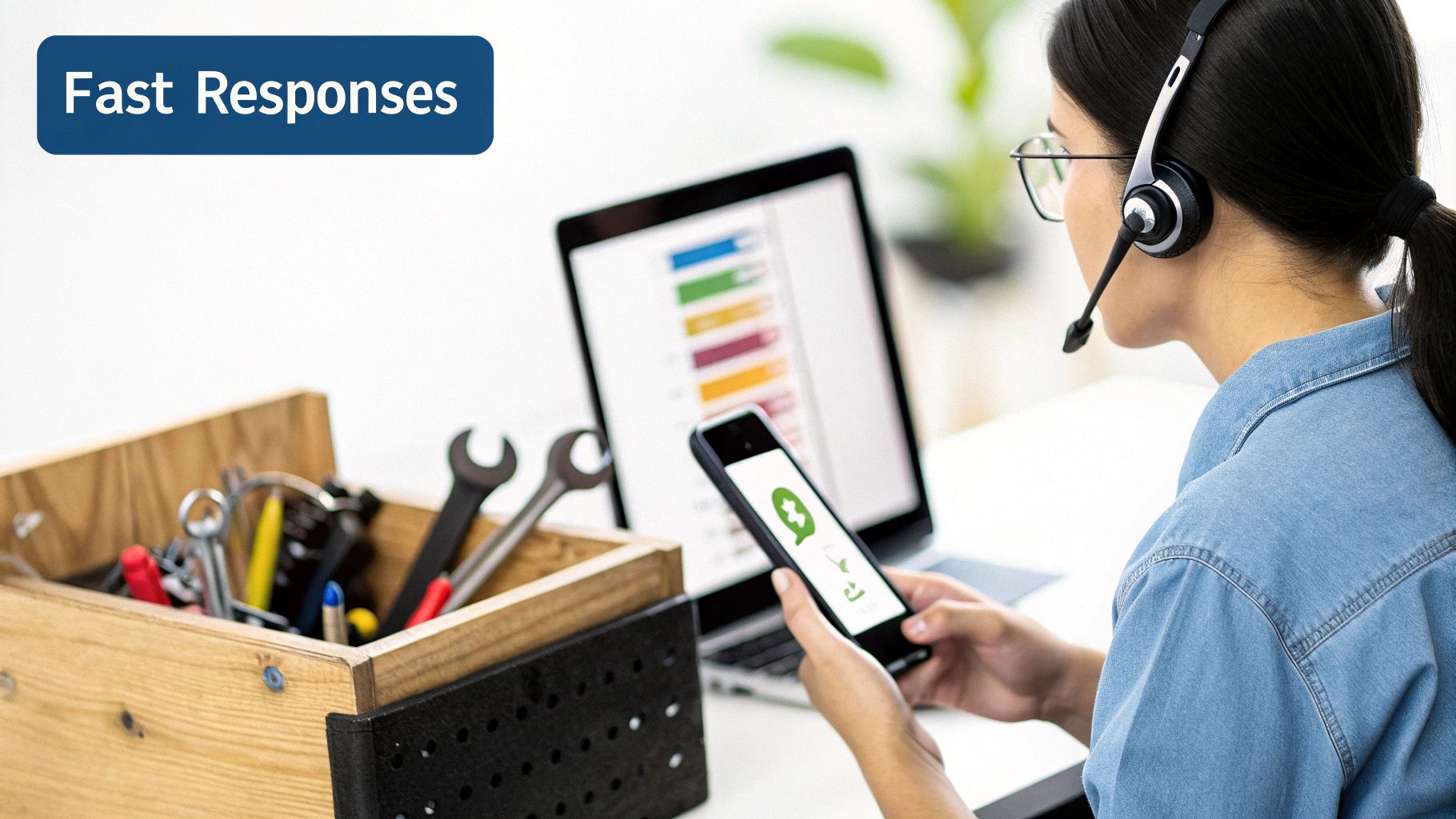
Choosing the right platform for WhatsApp Business with multiple users is a huge step, but it's just the beginning. The real magic happens in how you manage your team day-to-day. Without a clear game plan, even the best shared inbox can become disorganised.
This is where you shift from technical setup to team leadership. It's about creating a workflow so smooth that every customer gets great service, no matter who on your team is replying. The goal is to make your team’s collaboration invisible to the customer, presenting a single, unified, and professional front.
Create a Consistent Brand Voice
When several people are responding to customers, your brand's voice can get muddled. One person might be very formal, while another is too casual. This inconsistency can be jarring for customers, so defining your tone of voice is crucial.
A great starting point is to build a library of pre-approved quick-reply templates for frequently asked questions. This is a double win: it saves your team time and ensures your key information—on pricing, returns, or product details—is always accurate and on-brand.
For conversations that go off-script, a simple style guide makes a huge difference. Outline key phrases to use (and which to avoid), define your brand's personality, and share examples of good and bad responses. This gives your team the confidence to handle unique queries while staying true to your company's voice.
Establish Clear Rules of Engagement
A shared inbox without rules is a recipe for chaos. You'll get team members replying to the same customer, or worse—everyone assuming someone else has it covered, leaving urgent queries unanswered. You need to set clear guidelines.
First, define ownership. The moment a team member takes on a new chat, they should assign it to themselves. This small action sends a clear signal to the rest of the team: "I've got this."
Next, set clear expectations for response times. For example, you could aim to answer every new message within 15 minutes. This keeps everyone accountable and ensures customers aren't left waiting. This is especially important in the UK, where WhatsApp is the top social platform, with 73% of internet users active on it monthly. With that level of popularity, fast responses are non-negotiable. You can learn more about WhatsApp's UK user base on analyzify.com.
The secret to a perfect customer handover is using internal notes. An agent can leave a private comment like, "Customer is keen on the premium package but wants a call back tomorrow morning." This lets another team member step in later with the full picture, and the customer is none the wiser.
By combining the right technology with clear, common-sense rules, you can turn your WhatsApp channel into a well-oiled machine for building great customer relationships.
Common Questions About Multi-User WhatsApp
Even after exploring the options, it's natural to have questions when setting up WhatsApp Business for multiple users. Let's tackle some of the most common ones to help you make the right choice.
Can we use one WhatsApp Business number on multiple phones?
Yes, but it's important to understand the limitations. With the standard, free WhatsApp Business app, you can link your main business number to as many as four other devices (mobiles or computers). This can work for a very small team.
The catch is that everyone is using the same account. There’s no way to know who said what, assign conversations, or track performance. It’s a shared login. For a solo operator or a team of two, it might be fine. But as soon as you need more organisation, this shared approach can cause problems.
What is the real cost of using the WhatsApp Business API?
There isn't a single flat fee for the API, which can be surprising. The cost is typically split into two parts:
- WhatsApp's Conversation Fees: Meta (WhatsApp's parent company) charges a small fee per 24-hour messaging session with a customer. The price varies by country and depends on who started the chat—your business or the customer.
- Business Solution Provider (BSP) Subscription: You don't connect directly to the API yourself. Instead, you partner with a BSP. They provide the software—the shared inbox, analytics, etc.—that uses the API. They charge a monthly subscription for this service, which usually scales with the number of users and features you need.
When budgeting for a multi-user solution, you must account for both of these costs.
How can we keep our brand voice consistent with multiple agents?
This is a classic challenge, but it's manageable with the right tools and processes. You can't just hope for the best; you need a system to guide your team.
The most effective tool for consistency is a platform that supports 'quick replies' or 'canned responses'. This lets you build a library of pre-written answers for frequently asked questions, ensuring your key messages are always accurate and on-brand.
I also strongly recommend creating a simple style guide for the team. This document doesn't need to be long, but it should outline your brand's tone of voice, preferred terminology, and even how you use emojis. A little training and regular feedback go a long way in making sure every customer gets the same great experience.
What exactly is a Business Solution Provider (BSP)?
A Business Solution Provider (BSP) is a company officially approved by Meta to provide services using the WhatsApp Business API. They act as the essential bridge between your business and WhatsApp's advanced platform.
Instead of hiring developers to build a custom solution, BSPs offer ready-made software. They build the user-friendly platforms with shared team inboxes, CRM integrations, and chatbots. By subscribing to a BSP, you get all the power of the API—like assigning chats, running reports, and setting up automations—through an interface that's ready to use from day one.
Ready to give your business a dedicated, professional WhatsApp number without juggling a second phone or SIM card? With Business Numbers Direct, you can set up a virtual business number in minutes. It's the perfect way to separate your personal and work communications while unlocking all the powerful features of WhatsApp Business. Start your journey for just £7.99 per month and give your team the tools they need to succeed.

